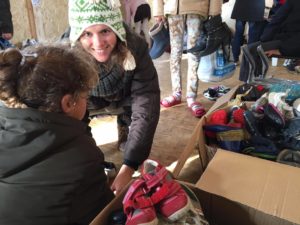For the majority of the day, Franz, Eugene and I were posted at the shoe distribution station.

I helped, or perhaps often more accurately watched, as mothers and children came in to collect one pair of winter shoes each. The initial plan had been that the volunteers would hand out the shoes and that people could not choose their own as the coordinators through this would be too chaotic. This plan must have gone out the window very quickly, before I even made it into the women and children shoe room shortly after it ‘opened for trading’. By the time I got there everyone was trying on shoes and sorting through the boxes as they wished, jumbling up the contents of the boxes, each neatly sorted by size. Any attempt to stop this was severely hindered by the language barrier and the mothers’ tenacity to find good pairs of shoes. Ultimately I couldn’t blame them though. It’s not easy to find a pair of shoes that fit, especially with the added challenge that most of the shoes are second hand. Some women turned up multiple times, which they weren’t allowed to do, and again I was confronted with the somewhat cold nature of the process – of the fact that privileged people are standing there telling people with less what they can and cannot have. On the other hand, without a system, there would almost certainly be chaos. Apparently it’s not uncommon for people to try to sneak more than they are allocated, outright steal and or fight for things. In the situation they are in I guess it’s not particularly surprising. I was left asking myself what being in such a position does to people, to their identity and sense of self.
In the afternoon I went to the mothers and babies’ room. Apart from being a nice respite for my feet, which had turned to ice blocks having not been covered by appropriate winter shoes, it was a lot of fun to sit with the children. About 15 girls came to the session where they could paint small canvases with a outline printed on them – almost everyone chose the canvas with the fairy on it. I was surprised by the poor fine motor skills of some of the children and by the fact that they did not know how to mix colours. I can’t really remember when I was taught this, but nevertheless found it a shame that they weren’t learning such things. I painted them a sheet showing how to make purple, green, orange, grey, pink – a colour that was in particularly high demand – and brown. It was really cool to see some of them passing the page around to each other, talking about it in Arabic and using it to make their own colours.
While sitting there I realised for the first time that children here are missing out on ‘proper’ schooling while. I wondered what this means for their future lives.
